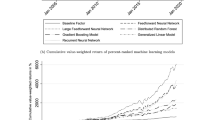Abstract
We examine the generating process for default risk premia in short-term and long-term debt sectors of the U.S. economy over the recent period of January 1977 through December 1996. Using weekly aggregates reported by the Federal Reserve, this research finds that all univariate series examined have unit roots which suggests a “long memory” for innovations in the series. Models presented here demonstrate an adjusted R2 of 59 to 97 percent in sample with similar hold-out sample results. Long-term investment grade corporate bonds exhibit substantial feedback such that lagged innovations have predictive power for nearby risk classes. In the money markets, the flow of information is from less risky assets to more risky assets.
Similar content being viewed by others
References
Bernanke, Ben S. 1990. “On the Predictive Power of Interest Rates and Interest Rate Spreads.”New England Economic Review: 51–68.
Beveridge, Stephen, and Charles R. Nelson. 1981. “A New Approach to Decomposition of Economic Time Series into Permanent and Transitory Components with Particular Attention to Measurement of the Business Cycle.”Journal of Monetary Economics 7: 151–174.
Brenner, Robin J., Richard H. Harjes, and Kenneth F. Kroner. 1996. “Another Look at Models of the Short-term Interest Rate.”Journal of Financial and Quantitative Analysis 31: 85–107.
Chan, K.C., G.A. Karolyi, F.A. Longstaff, and A.B. Sanders. 1992. “An Empirical Investigation of Alternative Models of the Short-term Interest Rate.”Journal of Finance 47: 1209–1227.
Clinebell, John M., Douglas K. Kahl, and Jerry L. Stevens. 1996. “Time Series Estimation of the Bond Default Risk Premium.”The Quarterly Review of Economics and Finance 36: 475–484.
Cook, Timothy Q., and Patrick H. Hendershott. 1978. “The Impact of Taxes, Risk and Relative Security Supplies on Interest Rate Differentials.”Journal of Finance 33: 1173–1186.
Fama, Eugene F., and Kenneth R. French. 1989. “Business Conditions and Expected Returns on Stocks and Bonds.”Journal of Financial Economics 25: 23–49.
Ferri, Michael G., and James P. Gaines. 1980. “A Study of Yield Spreads in the Money Market: 1971 to 1978.”Financial Management 9: 52–59.
Finnerty, John, and Dean Leistikow. 1993. “The Behavior of Equity and Debt Risk Premiums.”Journal of Portfolio Management 19: 73–84.
Fisher, Lawrence. 1959. “Determinants of Risk Premiums on Corporate Bonds.”Journal of Political Economy 67: 217–237.
Fullerton, Thomas M., Jr. 1993. “Predictability of Secondary-market Developing-country Debt Prices.”Applied Economics 25: 1365–1371.
Hamilton, James D. 1994.Time Series Analysis. Princeton: Princeton University Press.
Jaffee, Dwight M. 1975. “Cyclical Variations in the Risk Structure of Interest Rates.”Journal of Monetary Economics 1: 309–325.
Keim, Donald B., and Robert F. Stambaugh. 1986. “Predicting Returns in the Stock and Bond Markets.”Journal of Financial Economics 17: 357–390.
Kidwell, David, and Charles Trzcinka. 1979. “The Risk Structure of Interest Rates and the Penn-central Crisis.”Journal of Finance 34: 751–760.
Schwert, G. William. 1987. “Effects of Model Specification on Tests for Unit Roots in Macroeconomic Data.”Journal of Monetary Economics 20: 73–103.
Stanton, Richard. 1997. “A Nonparametric Model of Term Structure Dynamics and the Market Price of Interest Rate Risk.”Journal of Finance 52: 1973–2002.
Zellner, A. 1962. “An Efficient Method of Estimating Seemingly Unrelated Regressions and Tests of Aggregation Bias.”Journal of the American Statistical Association 57: 348–368.
Author information
Authors and Affiliations
Corresponding author
Additional information
Patrick A. Trachial, Technology House Inc.
This manuscript has benefited from the comments of Tom Fullerton, Ned Hill, Judy Maese, Ken Martin, Richard Sprinkle, and Bernell Stone. This manuscript was improved by comments received at the 13th International Symposium on Cash, Treasury, and Working Capital management (1997, Honolulu).
Rights and permissions
About this article
Cite this article
Traichal, P.A., Johnson, S.A. Forecastable default risk premia and innovations. J Econ Finan 23, 214–225 (1999). https://doi.org/10.1007/BF02757706
Issue Date:
DOI: https://doi.org/10.1007/BF02757706




